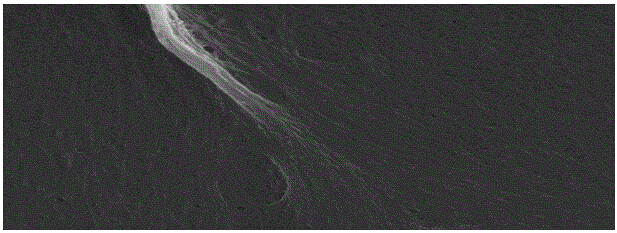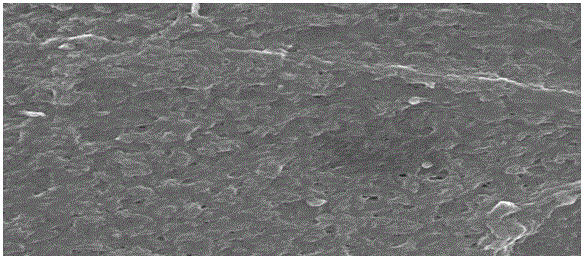Soft tissue engineering porous scaffold and preparation method thereof
A porous scaffold and soft tissue technology, applied in the field of biomedical materials, can solve the problems of difficult structure construction, poor film degradability, poor mechanical properties, etc., and achieve the effect of simple preparation process, good biocompatibility and low cost
- Summary
- Abstract
- Description
- Claims
- Application Information
AI Technical Summary
Problems solved by technology
Method used
Image
Examples
Embodiment 1
[0026] The porous scaffold for soft tissue engineering described in this example is made by compounding sodium carboxymethylcellulose, chitosan and polyvinylpyrrolidone, the mass ratio of sodium carboxymethylcellulose to polyvinylpyrrolidone is 1:3, and carboxymethylcellulose The mass ratio of sodium methylcellulose to chitosan is 1:1.
[0027] The preparation method of the soft tissue engineering porous scaffold described in this embodiment specifically includes the following steps:
[0028] (1) According to the mass ratio of sodium carboxymethylcellulose and polyvinylpyrrolidone of 1:3, weigh 1g of sodium carboxymethylcellulose powder and 3g of polyvinylpyrrolidone powder and mix well, add 20mL of water and stir Mix well in 20 minutes to obtain solution A;
[0029] (2) According to the mass ratio of sodium carboxymethylcellulose and chitosan of 1:1, weigh 1 g of chitosan powder and add it to 10 mL of acetic acid solution with a concentration of 0.5 mol / L, and stir at room t...
Embodiment 2
[0040] The porous scaffold for soft tissue engineering described in this example is made by compounding sodium carboxymethylcellulose, chitosan and polyvinylpyrrolidone. The mass ratio of sodium carboxymethylcellulose to polyvinylpyrrolidone is 1:0.1, and carboxymethylcellulose The mass ratio of sodium methylcellulose to chitosan is 1:1.25.
[0041] The preparation method of the soft tissue engineering porous scaffold described in this embodiment specifically includes the following steps:
[0042] (1) Take sodium carboxymethylcellulose and polyvinylpyrrolidone according to the mass ratio of 1:0.1, weigh 1g of sodium carboxymethylcellulose powder and 0.1g of polyvinylpyrrolidone powder and mix well, add 33mL of water Stir for 25 minutes and mix well to obtain solution A;
[0043] (2) According to the mass ratio of sodium carboxymethylcellulose to chitosan is 1:1.25, weigh 1.25g chitosan powder and add it to 20mL lactic acid solution with a concentration of 3mol / L, and stir at ...
Embodiment 3
[0051] The porous scaffold for soft tissue engineering described in this example is made by compounding sodium carboxymethylcellulose, chitosan and polyvinylpyrrolidone. The mass ratio of sodium carboxymethylcellulose to polyvinylpyrrolidone is 1:50, and carboxymethylcellulose The mass ratio of sodium methylcellulose to chitosan is 1:0.1.
[0052] The preparation method of the soft tissue engineering porous scaffold described in this embodiment specifically includes the following steps:
[0053] (1) Take sodium carboxymethylcellulose and polyvinylpyrrolidone according to the mass ratio of 1:50, weigh 1g of sodium carboxymethylcellulose powder and 50g of polyvinylpyrrolidone powder and mix well, add 255mL of water and stir Mix evenly for 30 minutes to obtain solution A;
[0054] (2) According to the mass ratio of sodium carboxymethylcellulose and chitosan 1:0.1, weigh 0.1g chitosan powder and add it to 15mL citric acid solution with a concentration of 2mol / L, and stir at room ...
PUM
| Property | Measurement | Unit |
|---|---|---|
| Concentration | aaaaa | aaaaa |
| Thickness | aaaaa | aaaaa |
| Tensile strength | aaaaa | aaaaa |
Abstract
Description
Claims
Application Information
 Login to View More
Login to View More - R&D Engineer
- R&D Manager
- IP Professional
- Industry Leading Data Capabilities
- Powerful AI technology
- Patent DNA Extraction
Browse by: Latest US Patents, China's latest patents, Technical Efficacy Thesaurus, Application Domain, Technology Topic, Popular Technical Reports.
© 2024 PatSnap. All rights reserved.Legal|Privacy policy|Modern Slavery Act Transparency Statement|Sitemap|About US| Contact US: help@patsnap.com









